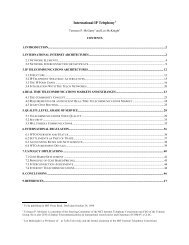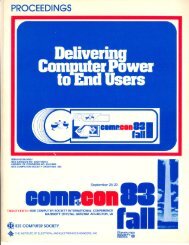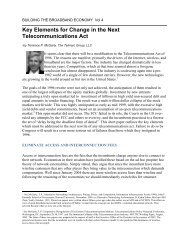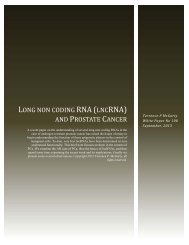progressivism, individualism, and the public ... - Telmarc Group
progressivism, individualism, and the public ... - Telmarc Group
progressivism, individualism, and the public ... - Telmarc Group
Create successful ePaper yourself
Turn your PDF publications into a flip-book with our unique Google optimized e-Paper software.
The <strong>Telmarc</strong> <strong>Group</strong><br />
PROGRESSIVISM, INDIVIDUALISM, AND THE PUBLIC<br />
INTELLECTUAL<br />
agree to what must be done in <strong>the</strong>ir community <strong>and</strong> <strong>the</strong> Federal Government is<br />
h<strong>and</strong>s off. In a sense this is libertarian or as Miller calls <strong>the</strong>m market anarchists 194 .<br />
Each to <strong>the</strong>ir own <strong>and</strong> each entity or individual is free to choose, decide <strong>and</strong> <strong>the</strong>n<br />
a mechanism to clear any transactions <strong>and</strong> that mechanism is <strong>the</strong> market <strong>and</strong> not<br />
<strong>the</strong> government.<br />
4. Segmented: A segmented political architecture is really a hybrid. Each segment<br />
uses a sub political architecture, a community, that meets <strong>the</strong> requirements of <strong>the</strong><br />
existing system but <strong>the</strong>n networks are interconnected through st<strong>and</strong>ard political,<br />
economic, or social interfaces. In a political sense this is a confederation, an<br />
architecture where states or communities have <strong>the</strong> ultimate power. Miller calls<br />
<strong>the</strong>se communitarian anarchists 195 .<br />
7.2 SOCIALISM: THEN AND NOW.<br />
There has been significant talk that <strong>the</strong> current administration is socialistic. It is worth<br />
looking at this issue as compared to <strong>the</strong> neo-progressive approach which we have been<br />
arguing.<br />
As regards to <strong>the</strong> socialist platform I can approach this in a ra<strong>the</strong>r personal manner<br />
having been brought up with <strong>the</strong> conversations at <strong>the</strong> kitchen table. In 1920 my<br />
gr<strong>and</strong>mo<strong>the</strong>r, Hattie Kruger, ran on <strong>the</strong> Socialist Party ticket for Treasurer for <strong>the</strong> State of<br />
New York. In 1917 she was arrested by President Wilson for protesting <strong>the</strong> War <strong>and</strong> also<br />
for protesting <strong>the</strong> Women's failure to have <strong>the</strong> vote. In 1916 she was <strong>the</strong> Socialist Party<br />
c<strong>and</strong>idate for US Senate from New York. 196 .<br />
Following on a previous discussion, we can now ask what were <strong>the</strong> paradigms that drove<br />
<strong>the</strong> Socialists world view <strong>and</strong> what is different from <strong>the</strong>n <strong>and</strong> now, if anything. To do this<br />
we will examine <strong>the</strong> Socialist Party platform during this period 197 .<br />
194 Miller. Political, p. 25.<br />
195 Miller, Political, p. 25.<br />
196 See: http://memory.loc.gov/cgi-bin/query/S?ammem/mnwp:@FIELD(SUBJ+@od1(+kruger,+hattie+)) some of<br />
<strong>the</strong> picket line of Nov. 10, 1917. Left to right: Mrs. Ca<strong>the</strong>rine Martinette, Eagle Grove, Iowa. Mrs. William Kent,<br />
Kentfield, California. Miss Mary Bartlett Dixon, Easton, Md. Mrs. C.T. Robertson, Salt Lake City, Utah. Miss Cora<br />
Week, New York City. Miss Amy Juengling, Buffalo, N.Y. Miss Hattie Kruger, Buffalo, N.Y. Miss Belle Sheinberg,<br />
N.Y.C. Miss Julia Emory, Baltimore, Md. 1917 Nov. 10 Summary: Photograph of nine suffrage pickets st<strong>and</strong>ing<br />
single file along a tall lattice fence, with suffrage banners. Left to R: Ca<strong>the</strong>rine Martinette, Elizabeth Kent, Mary<br />
Bartlett Dixon, C. T. Robertson, Cora Week, Amy Jungling, Hattie Kruger, Belle Sheinberg, Julia Emory. Title<br />
transcribed from item. Cropped version of <strong>the</strong> photograph published in The Suffragist, 5, no. 95 (Nov. 17, 1917):<br />
197 Also see Kagan, E, TO THE FINAL CONFLICT: SOCIALISM IN NEW YORK CITY, 1900-1933, Thesis BA<br />
Princeton, April 1981. Kagan approaches this period in a manner which is dramatically different from what I had<br />
been exposed to. There were indeed many conflicts in <strong>the</strong> Socialists ranks, <strong>the</strong>re were German Jews versus Eastern<br />
European Jews, intellectuals versus raw union types, <strong>and</strong> each group fought each o<strong>the</strong>r. The key factor for each<br />
however was state ownership of <strong>the</strong> dominant industries, railroads, telephone, water, <strong>and</strong> <strong>the</strong> like. It was a reaction<br />
to Trusts as was <strong>the</strong> entire Progressive movement.<br />
Page 194












